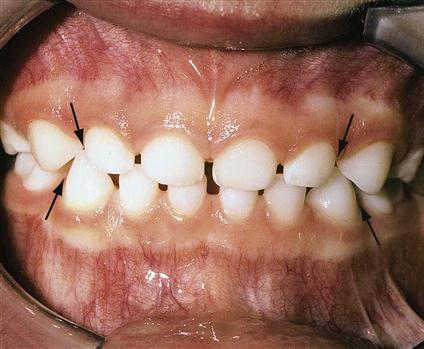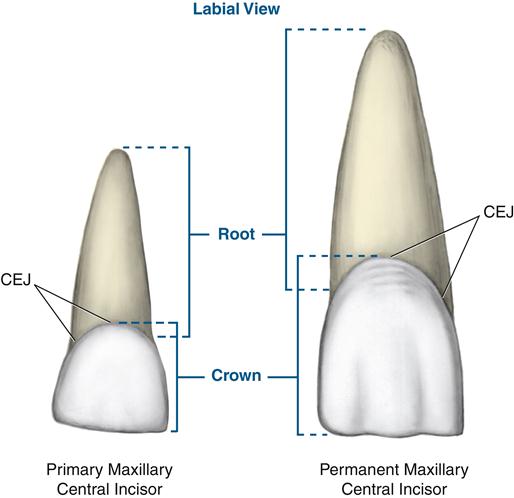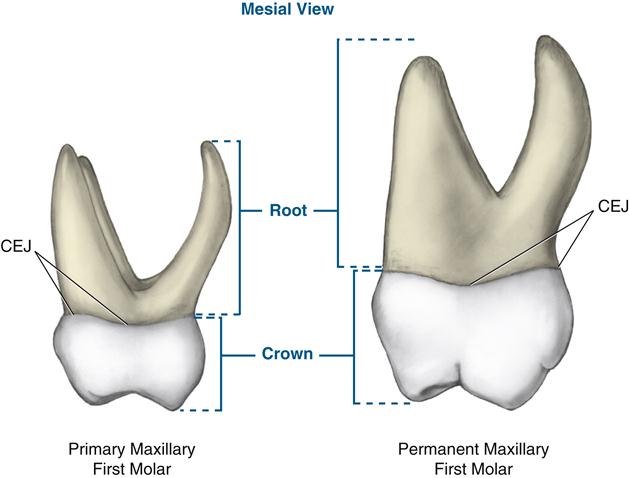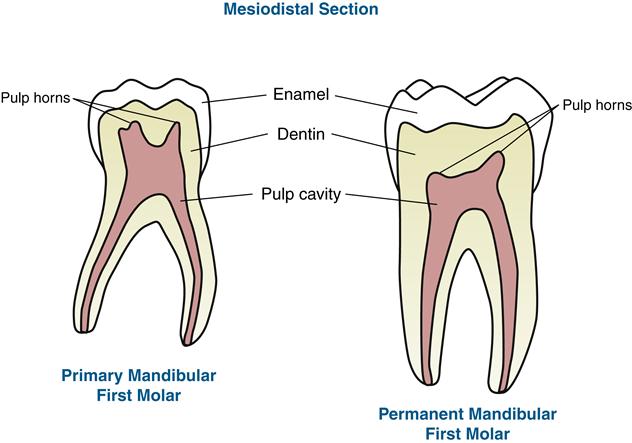Primary Dentition
Learning Objectives
• Demonstrate the correct location of each primary tooth on a diagram and a patient.
• Define and pronounce the key terms when discussing the primary teeth.
• Describe the general features of primary teeth and of each primary tooth type.
New Key Terms
Early childhood caries
Primate spaces
Primary Teeth
The first set of teeth is the primary dentition (Figure 18-1). The primary dentition is exfoliated, or shed, and replaced by the permanent dentition. There are 20 total primary teeth when the primary dentition period is completed, 10 per dental arch. These include the tooth types of incisors, canines, and molars (see Figure 15-1). These are designated in the Universal Tooth Designation System by the capital letters A through T. There are no premolars in the primary dentition as there are in the permanent dentition.
Mineralization of the primary teeth begins in utero at 13 to 16 weeks. By 18 to 20 weeks during prenatal development, all the primary teeth have started to mineralize. There are usually no primary teeth visible in the oral cavity at birth. The first eruption of a primary tooth, a primary mandibular central incisor, occurs at an average age of 6 to 10 months, with the further eruption of the rest of the primary dentition following (Table 18-1).
TABLE 18-1
Approximate Eruption and Shedding Ages for Primary Teeth
| MAXILLARY TEETH | ERUPTION, MEAN (RANGE) | SHEDDING, RANGE |
| Central incisor | 10 (8-12 months) | 6-7 years |
| Lateral incisor | 11 (9-13 months) | 7-8 years |
| Canine | 19 (16-22 months) | 10-12 years |
| First molar | 16 (13-19 months, males and 14-19 months, females) | 9-11 years |
| Second molar | 29 (25-33 months) | 10-12 years |
| MANDIBULAR TEETH | ERUPTION | SHEDDING |
| Central incisor | 8 (6-10 months) | 6-7 years |
| Lateral incisor | 13 (10-16 months) | 7-8 years |
| Canine | 20 (17-23 months) | 9-12 years |
| First molar | 16 (14-18 months) | 9-11 years |
| Second molar | 27 (23-31 months, males and 24-30 months, females) | 10-12 years |
Adapted from Nelson S: Wheeler’s Dental Anatomy, Physiology and Occlusion, ed 9, WB Saunders, Philadelphia, 2009.
The primary dentition takes between 2 to 3 years to be completed, beginning with the initial mineralization of the primary mandibular central incisors, and later being completed with root formation in the primary maxillary second molar (see Figure 6-22, A). A 6-month delay, or acceleration, is considered normal for an individual child. If a child patient is unusually early or late in getting their teeth, it is important to inquire about the family’s dental history concerning this issue.
The actual dates are not as important as the eruption sequence because, even though there can be a great deal of variation in the actual dates of eruption noted in various texts. However, the sequence tends to be uniform (see Figure 20-5). In addition, the specific tooth types tend to erupt in pairs so that if there is any asymmetry noted within the primary dentition, a radiograph of the area may be required. Young girls tend to both shed their primary teeth and have their permanent teeth slightly earlier than young boys, possibly reflecting the earlier overall physical maturation achieved.
Also, certain interproximal spaces between the primary teeth are considered normal in most child patients, because space is necessary for the proper alignment of the future permanent dentition. These spaces still may concern the supervising adults, and they may need reassurance. These spaces are considered primate spaces, mainly involving spaces between the primary maxillary lateral incisor and canine, and also between the primary mandibular canine and first molar (see Figure 18-1, Chapter 20).
Comparison of Primary to Permanent Teeth
Primary teeth are smaller overall than permanent teeth. However, the primary teeth should not be considered just mini-me permanent teeth, because there are important differences that occur in the structure of primary teeth compared with that of permanent teeth (Figures 18-2 to 18-4).
The crown of any primary tooth is short in relation to its total length. The crowns are also more constricted, or narrower, at the cementoenamel junction (CEJ), making them appear bulbous in comparison to the thinness of the tooth neck. A prominent cervical ridge is present on both the labial and lingual surfaces of anterior teeth and on buccal surfaces of the molars, even more so than any similar structure on the even larger permanent molars (see Figure 18-4).
Roots of primary teeth are also narrower and longer than the crown length (see Figures 18-2 to 18-4). Each crown to root ratio of primary teeth are smaller than those ratios of their permanent dentition counterparts. Roots may also show partial resorption as the teeth begin to be shed, which can be noted radiographically (see Figure 6-27, A).
The pulp cavity on primary teeth shows that pulp chambers and pulp horns are relatively large in proportion to those of the permanent teeth, especially the mesial pulp horns of the molars (Figure 18-5). Overall, the dentin of the primary dentition is thinner than that of the permanent counterparts. However, the dentin thickness between the pulp chambers and the enamel is increased, especially in the primary mandibular second molar. The enamel is also relatively thin in comparison to permanent counterparts, but has consistent thickness overlying the dentin of the crown. However, primary teeth also have whiter enamel on their crowns than the permanent teeth, because of the increased opacity of the enamel, which covers the underlying yellow dentin.
Primary Incisors
General Features
Each dental arch has four primary incisors. As in the permanent dentition, each quadrant has two incisor types: central incisor and lateral incisor. Both primary incisors resemble their permanent successor,
Stay updated, free dental videos. Join our Telegram channel

VIDEdental - Online dental courses







